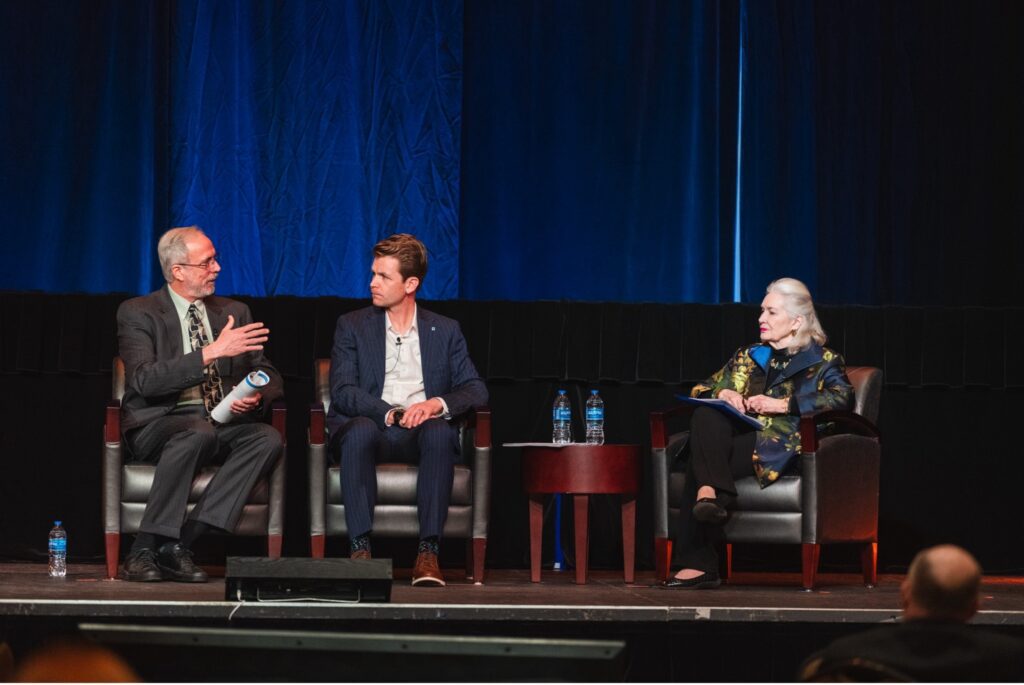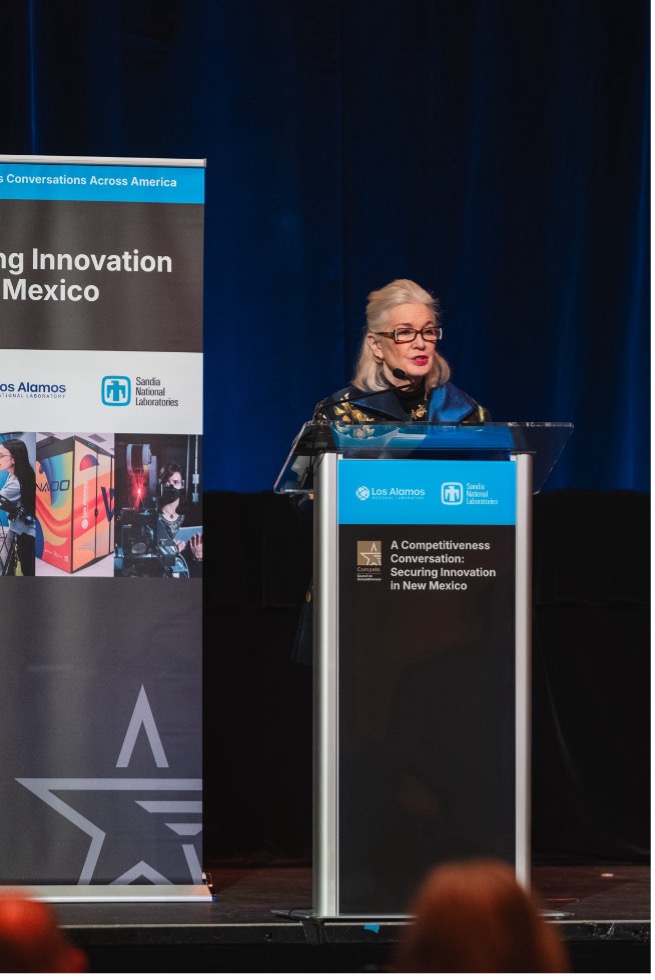
Council on Competitiveness President and CEO Deborah L. Wince-Smith joined U.S. Department of Energy national laboratory leaders to kick off the New Mexico edition of the “Competitiveness Conversations Across America” series — taking place under the auspices of the “National Commission on Innovation and Competitiveness Frontiers” — framing the grand challenges and opportunities facing New Mexico and the United States.
To open the Conversation, Council on Competitiveness President and CEO Deborah Wince-Smith stepped to the podium to introduce the audience of innovation leaders from across the state and region to the Council on Competitiveness, which for 39 years has defined U.S. competitiveness and shaped the agenda driving productivity, growth, security, and the global success of U.S. goods and services.

"The United States cannot continue to have economic and social disparities so embedded across our nation. We must bring all Americans into the innovation ecosystem that we have built that made the nation so successful."
The Hon. Deborah Wince-Smith
President and Chief Executive Officer
Council on Competitiveness and National Commission Co-Chair
One of the most significant challenges the Council is working to address today is the risks posed by a hyper-concentration of America's innovation assets in a few densely populated, extremely costly innovation hubs like San Francisco and Boston. The United States cannot afford to continue with such deep economic and social disparities, and the country must bring many more communities and Americans into the innovation ecosystem to meet the challenges and opportunities brought on by accelerating global competition.
One state with an accelerating innovation-based economy — and which other states could garner insights to emulate — is New Mexico. The state has a long-standing legacy of advancing American competitiveness and national security, dating back to the Manhattan Project at Los Alamos, where wartime research helped the United States prevail over the fascist powers in World War II. That legacy continues today through Los Alamos National Laboratory and Sandia National Laboratories, which play a central role in designing, testing, and maintaining the nation’s nuclear deterrent. However, the influence of these two U.S. Department of Energy National Laboratories extends well beyond national security — these institutions advance cutting-edge research, including some of the world’s most powerful supercomputing applications in machine learning and AI, while also serving as major economic engines for the region. They employ over 30,000 people and generate more than $10 billion in annual economic impact.
New Mexico’s two R1 research universities, the University of New Mexico and New Mexico State University, along with a strong base of technical and community colleges, contribute to a robust talent and innovation pipeline. This ecosystem has played a part in the state’s impressive 7 percent year-over-year GDP growth from 2022 to 2023, more than doubling the national rate of 3 percent. New Mexico ranks third in federal R&D funding, with research and development accounting for about 6 percent of the state’s GDP — the highest share of value-added by research of any state in the country.
Ms. Wince-Smith, in her opening remarks, highlighted the surge of high-tech industries establishing roots in New Mexico, including Intel’s $4 billion investment in semiconductor research and development. The state is also home to over 50 aerospace companies, including SpaceX and Virgin Galactic, attracted by the talent pool and the expansive restricted airspace at Spaceport America. The aerospace industry alone has created 16,000 jobs and contributed $2 billion to the state’s GDP, with Kirtland Air Force Base generating over $900 million annually in research funding. Advanced manufacturing, driven by companies like Intel and Ebon Solar, adds an additional $3 billion to New Mexico’s GDP.
Following her opening remarks, Ms. Wince-Smith invited the panel to begin the day’s first discussion. Joined by Dr. Patrick Fitch, Deputy Director for Science, Technology, and Engineering at Los Alamos National Laboratory, and Mr. Josh Parsons, Sandia National Laboratories Associate Laboratories Director, Ms. Wince-Smith asked for insights from these two leaders about the challenges and opportunities facing New Mexico’s innovation ecosystem.
New Mexico’s national laboratories are not merely centers of research — they are deeply woven into the cultural, historical, and economic fabric of the state.
As Josh Parsons of Sandia National Laboratories remarked, “So much of the U.S. Department of Energy national laboratory enterprise is tied to New Mexico.” This bond originates in part from the U.S. Department of Energy National Laboratories’ roots in the Manhattan Project, which introduced a lasting mystique around New Mexico’s role in national security. Over the decades, the laboratories have become cornerstones of both national service and local heritage, serving dual roles: advancing essential missions in national defense and scientific innovation, while also acting as significant contributors to New Mexico’s economy and communities.

“The heritage of New Mexico and the U.S. Department of Energy National Laboratories are synergistic in nature.”
Mr. Josh Parsons
Associate Laboratories Director
Sandia National Laboratories
This enduring legacy and brand power are particularly evident in Los Alamos National Laboratory, where the intersection of history and innovation continues to shape its role. Ms. Wince-Smith highlighted the recent Oppenheimer film as a catalyst for renewed interest in the lab’s historic role. While that may be true, Dr. Fitch noted that many Americans are still unaware of the full scope of work done by the national laboratories.
Enhancing public understanding of the work done at U.S. DOE National Laboratories is crucial to reinforcing New Mexico’s innovation ecosystem and brand.
Only when the public and potential partners understand the depth of the DOE labs’ capabilities — and how they can work with and benefit from the talent and infrastructure available through them — will they fully invest in the region. Therefore, increasing the visibility of the labs’ work can lead to more collaborations between universities, private sector businesses, and even the labs, which is necessary to create a thriving, interconnected network of innovation. Furthermore, showcasing the transformative work being done at the laboratories can inspire future generations of scientists, engineers, and entrepreneurs, ensuring a continuous influx of talent and ideas into New Mexico’s workforce. This, in turn, creates a virtuous cycle, strengthening the state’s competitive edge, positioning it as an attractive location for high-tech industries and new business ventures, while preserving the legacy of the labs as both a national and local asset.

“We think innovation is an important part of the future in three ways: people, partnerships, and how we select focus areas.”
Dr. Patrick Fitch
Deputy Director
Science, Technology, and Engineering
Los Alamos National Laboratory
Building on this foundational legacy, today’s U.S. DOE national laboratory leaders are reimagining how these institutions can continue to drive innovation in a rapidly changing technological landscape. Dr. Fitch described innovation as a forward-looking mission that depends on three pillars: people, partnerships, and selecting the right areas of focus.In line with the first pillar, Los Alamos National Laboratory plays a crucial role in developing the state’s workforce, focusing on both recruitment and retention strategies to ensure a pipeline of skilled professionals for the future. The laboratory offers extensive training in business planning and entrepreneurial thinking, equipping employees with valuable skills whether they choose to venture beyond the lab or grow their careers within it.
However, recruiting and retaining top talent remains challenging for both Los Alamos National Laboratories and Sandia National Laboratories, particularly in competition with private industry. At Sandia, efforts like the “Unleash Excellence” program are helping cut through red tape and make federal lab careers more dynamic and appealing. Attrition has fallen below 5 percent, and Mr. Parsons noted that the goal is to make Sandia not just a workplace, but a long-term professional home. Similarly, Los Alamos National Laboratory has proactively addressed its demand for skilled workers by forging partnerships with local colleges and universities. This collaboration is central to building a sustained talent pipeline and engaging the community in the lab’s mission. Additionally, Los Alamos National Laboratory has introduced more flexible and non-committal employment pathways, particularly for non-scientific staff, which have proven effective in retaining a more diverse workforce.
The second pillar — partnerships — acknowledges that scientific leadership increasingly depends on collaboration with a private sector that is moving faster than ever. Companies like NVIDIA are breaking ground in artificial intelligence, often setting the pace for global innovation. Rather than compete, Los Alamos National Laboratory is actively seeking ways to align with these firms to accelerate its own research and bring new tools and technologies into its workstreams. Such partnerships help the lab remain agile and expand the reach of its scientific mission.
Furthermore, Los Alamos National Laboratory is strategically concentrating its research in high-impact areas, including biotechnology, quantum sensing, artificial intelligence, and space science. Each of these fields offers rich potential for cross-sector collaboration. The laboratory’s early involvement in the Human Genome Project — alongside Lawrence Livermore and Lawrence Berkeley National Laboratories — offers a compelling precedent. There, the integration of federal infrastructure and industrial capability accelerated scientific breakthroughs. Today, emerging technologies like AI serve similar roles: enabling researchers to interpret complex data, spot failed experiments early, and generate entirely new lines of inquiry.
Yet even with these advances, concerns remain. Dr. Fitch warned that without steady investment — particularly when compared to China’s aggressive spending on research — the United States could fall behind in the fields that will underpin the future economy and national security. The effects would not be immediate, but once the gap becomes clear, it will be difficult to recover.
Wrapping up the panel, Ms. Wince-Smith noted that by strengthening this interconnected ecosystem and increasing national awareness of the U.S. DOE National Laboratories’ transformative work, New Mexico can continue to lead in emerging technologies, while anchoring long-term economic development, talent retention, and global competitiveness.